#motor stator
Explore tagged Tumblr posts
Text
Design and manufacture of axial flux permanent magnet motors
Axial flux motors are extremely high efficiency motors where low form factor is essential. The applications for such stators are in Elevator Traction Motors (Roomless elevator design), Direct Drive Appliance Motors, EV Motor Applications,etc.
YOUYOU has developed a unique technology to manufacture axial flux motor cores.
Diameter range:20mm to 2 meter.
Email: [email protected]
Whatsapp:086-18826897469
Web: https://www.istator.com/axial-flux-stator.html
2 notes
·
View notes
Text
Sparrow Series APM40 KV380 Brushless Motor | High-Efficiency UAV Motor
Discover the Sparrow Series APM40 KV380 Brushless Motor by ePropelled, designed for high-efficiency UAV propulsion. Lightweight, powerful, and optimized for drone applications.
#Brushless Motor#APM40 brushless motor#Sparrow Series APM40#UAV motor#drone propulsion#high-efficiency motor#lightweight brushless motor#electric propulsion#ePropelled UAV motor#430W Drone Motor Replacement#Air Propulsion Motors for Drones#Propellers#APM40 Sparrow Series motor#ePropelled APM40 Sparrow Series motor#frameless stators and rotors#Drone Motor Replacement
0 notes
Text
Stator Winding Process A Comprehensive Guide
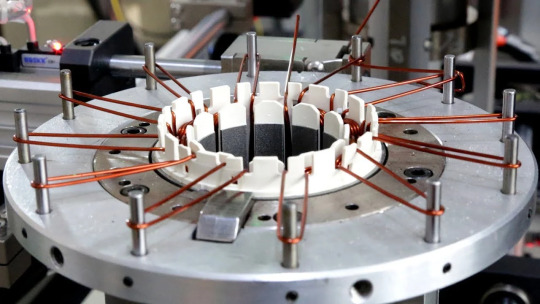
One of the most important concepts in electrical engineering is stator winding, which describes the painstaking process of creating coils inside the stator, which is an essential part of electric motors. Electromechanical systems rely heavily on these complex windings to transform electrical energy into mechanical power.
0 notes
Text
Temperature Condition for Brushless Motor Magnets
Temperature Condition for Brushless Motor Magnets Brushless motors use permanent magnet as one of their key components. These magnets usually use high-performance permanent magnet materials, such as rare earth neodymium strong magnets, mainly arc-shaped, fan-shaped, wedge-shaped, and rectangular. Today, this article mainly introduces the temperature requirements of brushless (DC) motor…
#AC motors#bonding neodymium iron boron#Brushless motor magnets#DC motors#Embedded Permanent Magnets#Ferrite magnet#high-performance permanent magnet motors#interior permanent magnet motors#IPM motors#magnet working temperature#Magnetic alloy#magnetic field#magnetic fields#magnetic flux density#magnetic forces#magnetic parameters#magnetic properties#Magnetic stators#Magnetic torque#magnetization direction#Magnets Temperature#motor magnets#permanent magnet motors#Permanent Magnets#PM Motors#rotor and stator#SPM motors#surface permanent magnet motors#Surface Permanent Magnets
0 notes
Video
youtube
300 tons of gantry high-speed punching machine stamping motor stator rot...
0 notes
Text

Bacterial flagellar motor
The bacterial flagellar motor (BFM) is a rotary molecular motor embedded in the cell membrane of numerous bacteria. It turns a flagellum which acts as a propeller, enabling bacterial motility and chemotaxis. The BFM is rotated by stator units, inner membrane protein complexes that stochastically associate to and dissociate from individual motors at a rate which depends on the mechanical and electrochemical environment. Stator units consume the ion motive force (IMF), the electrochemical gradient across the inner membrane that results from cellular respiration, converting the electrochemical energy of translocated ions into mechanical energy, imparted to the rotor.
#microbiology#gif#science#tech#consciousness#energy#engineering#godhood#technology#biology#nature#light#life#bfm#bacterial flagellar motor
39 notes
·
View notes
Text
Terms and definitions that you can maybe apply to your fan works
I don't know anything about computer or mechanical engineering (it's very funny to me that I am in the Transformers fandom and I don't even care about cars), but I do care about improving my writing. I have gathered a list of terms that sound very sciencey and applicable to mechs, some from Martha Wells's "Murderbot Diaries," some from fanfiction/fandom (shout-out to the Crime in Crystals series by Aard_Rinn and Baebeyza, they wrote Transformers better than any Transformers comic/TV show did), and a lot from just surfing through Google and going, "well, what the hell is this? Okay, but what the hell is THAT?".
Also, as I was writing this post, I ended up getting sucked into this article:
And this really bloated my already long list of terms. Very easy to read if you want to glance it over yourself.
It's not an exhaustive list and who knows if it will be useful to you - but maybe you can reblog with your own add-ons of terms and definitions you think make a Transformers fan work just that much better.
The list is below the cut:
100% CPU Load - CPU is fully occupied with too many processors/applications/drivers/operations - not necessarily synonymous with an overload.
Actuators* - A device that causes a machine or other device to operate (Ex: a computerized unit instructs the actuator how to move the tires on a vehicle); create linear and rotary movement (Ex: A hydraulic actuator on a valve will move that valve in response to a sensor/signal); Linear actuators "move a piston back and forth inside a cylinder to build pressure and 'actuate', or complete an action".
* Think of actuators as devices that help produce linear motion and motors as devices that help produce rotational movement. Hence, some consider actuators as a type of motor. But a motor is not a type of actuator (jhfoster.com).
Alternator - Converts mechanical energy to electrical energy with an alternating current. The stator and rotor inside the alternator work as magnets and rotate to generate the alternating current. Then the alternating current (AC) is transformed into a direct current (DC) that charges the battery.
Archive (Archive files) - used to collect multiple data files together into a single file for easier portability and storage, or simply to compress files to use less storage space.
Arithmetic Log Unit (ALU) - the part of a central processing unit that carries out arithmetic and logic operations on the operands in computer instruction words. In some processors, the ALU is divided into two units: an arithmetic unit (AU) and a logic unit (LU).
Augment - Make something greater; increase.
Auxiliary Battery - Designed to run as a backup to the starting battery and provide power to some essential equipment like engine start/stop and other systems that require power while the engine is off to put less strain on the main battery and alternator.
Bandwidth - A measurement indicating the maximum capacity of a wired or wireless communications link to transmit data over a network connection in a given amount of time.
Behavioral Coding - A term used in Martha Wells' Murderbot Diaries; essential, code for behaviors.
Branch Instructions - Use programming elements like if-statements, for-loops, and return-statements; used to interrupt the program execution and switch to a different part of the code.
Branch Predictors - Track the status of previous branches to learn whether or not an upcoming branch is likely to be taken or not.
Buffer - A region of memory used to store data temporarily while it is being moved from one place to another.
Cathodes vs Anodes - Cathodes are the positive electrode while the anode is the negative electrode; electrons flow from the anode to the cathode and this creates the flow of electric charge in a battery or electrochemical cell.
Catastrophic Failure - Complete, sudden and unexpected breakdown in a machine, indicating improper maintenance.
Central Processing Unit (CPU) - Primary component of a computer that acts as its "control center"; complex set of circuitry that runs the machine's operating systems and apps; the brains of the computer. * Components: Instruction Set Architecture (ISA), Control Unit (CU), Datapath, Instruction Cycle, Registers, Combinational Logic, the Arithmetic Logic Unit (ALU), etc...
Clock - Determines how many instructions a CPU can process per second; increasing its frequency through overclocking will make instructions run faster, but will increase power consumption and heat output.
Combustion Chambers - An enclosed space in which combustion takes place, such as an engine; jet engines also have combustion chambers.
Condition Codes - Extra bits kept by a processor that summarize the results of an operation and that affect the execution of later instructions.
Control Bus - Manages the communication between the computer's CPU and its other components.
Control Unit (CU) - Manages the execution of instructions and coordinates data flow within the CPU and between other computer components.
Cybermetal - Element native to Cybertron and Cybertron alone.
Datapath - The path where data flows as it is processed; receives input, processes it, and sends it out to the right place when done processing; datapaths are told how to operate by the CU; depending on instructions, a datapath can route signals to different components, turn on and off different parts of itself, and monitor the state of the CPU.
Diagnostic and Data Repair Sequence - Term used in Martha Wells' Murderbot Diaries; exactly what it sounds like.
Diode - A semiconductor device with two terminals (a cathode and an anode), typically allowing the flow of current in one direction only.
Discrete Circuit vs Integrated Circuit- Single device with a single function (ex: Transistor, diode) vs Devices with multiple functional elements on one chip (ex: Memories, microprocessor IC and Logic IC).
Drivers - A set of files that help software (digital components, such as Microsoft Office) interface/work with hardware (physical components, such as a keyboard); allows an operating system and a device to communicate.
Electromagnetic (EM) Field - A combination of invisible electric and magnetic fields of force; used in fandom by mechs to broadcast emotions to others.
Flags - A value that acts as a signal for a function or process. The value of the flag is used to determine the next step of a program; flags are often binary flags which contain a boolean value (true or false).
Full Authority Digital Engine Control (FADEC) - Consists of an electronic control unit (ECU) and related accessors that control aircraft engine performances.
Gestation Tank - Used in mech pregnancies, you can pry it from my cold, dead hands.
Heads Up Display (HUD) - A part of the user interface that visually conveys information to the player during gameplay.
Heat Spreader - Often used in computer processors to prevent them from overheating during operation; transfers energy as heat from a hotter source to a colder heat sink or heat exchanger.
HUB - A device that connects multiple computers and devices to a local area network (LAN).
Inductive Charging - How I imagine berths work; wireless power transfer (ex: Wireless charger or charging pad used for phones).
Instruction Cycle - Also known as fetch-decode-execute cycle; basic operation performed by a CPU to execute an instruction; consists of several steps, each of which performs a specific function in the execution of the instruction.
Instruction Set Architecture (ISA) - The figurative blueprint for how the CPU operates and how all the internal systems interact with each other (I think of it like a blueprint for the brain).
Irising - Term used in fanfiction (specifically the Crime in Crystals series) to describe the action of the of the spark chamber opening ("The Talk", chapter 6, my absolute favorite chapter out of the entire series). I just really liked how the word sounded in that context.
Life Codes - "For those of us who were forged, Primus, through Vector Sigma, generated a pulse wave. Each one a data-saturated life code faster than thought, brighter than light, racing across Cybertron, sowing sparks..." (~Tyrest/Solomus, Volume 5 of More Than Meets the Eye)
Memory Hierarchy - Represents the relationship between caches, RAM, and main storage; when a CPU receives a memory instruction for a piece of data that it doesn't yet have locally in its registers, it will go down the memory hierarchy until it finds it.
Levels: L1 cache (usually smallest and fastest), L2 cache, L3 cache, RAM, and then main storage (usually biggest and slowest); available space and latency (delay) increase from one level to the next
Depending on the multi-core (a core is usually synonymous with a CPU) system, each core will have its own private L1 cache, share an L2 with one other core, and share an L3 with more or more cores.
Motors* - Any power unit that generates motion; electric motors work by converting electrical energy into mechanical energy... when this happens within a magnetic field, a force is generated which causes shaft rotation.
Multitasking Operating System - Allows users to run multiple programs and tasks almost simultaneously without losing data; manage system resources (such as computer memory and input/output devices), allocate resources, enable multiple users, and eliminate long wait times for program execution.
Network - A set of computers sharing resources located on or provided by network nodes. Computers use common communication protocols over digital interconnections to communicate with each other.
Network Feed - The continuously updating stream of content that users encounter on networking platforms.
Neural Network - A type of machine learning process that uses interconnected nodes (like neurons) to teach computers to process data in a way similar to the human brain; a form of deep learning that can help computers learn from their mistakes and improve their time.
Nimbus - A luminous cloud or a halo surrounding a supernatural being or a saint; has been used in fanfiction synonymously or in junction with the corona of the spark.
Nodes - A connection point between devices that allows data to be sent and received between them.
Oil Sump/Oil Pan - Don't forget to change your mech's oil.
Out-Of-Order Execution - A paradigm used to minimize downtime while waiting for other instructions to finish; allows a CPU to choose the most timely instructions to execute out of an instruction queue.
Overload - Orgasm; an electrical overload occurs when too much electricity passes through a circuit, exceeding its capacity; an information overload is when a system receives more input than it can process, or a state of being overwhelmed by the amount of data presented for processing.
Pedes - Feet
Pipelining - A technique used in computer architecture that allows a processor to execute multiple instructions simultaneously, improving overall performance.
Processing Capacity - The ability and speed of a processor, and how many operations it can carry out in a given amount of time.
Program Counter - A special register in a computer processor that contains the memory address (location) of the next program instruction to be executed.
Programmable Nanobots/Nanites - Cybertronian microbots programmed to do work at the molecular level; used popularly for surface healing and pigment in mechs.
Protected Storage - Provides applications with an interface to store user data that must be kept secure or free from modification; a storage method; a function in mainframe hardware.
Protoform - Formed of an ultra-dense liquid metal and are extremely hard to damage; the most basic Cybertronian form of raw, free-flowing living metal; first stage of Cybertronian life cycle
To create a Cybertronian, you need the protoform, the life-giving spark, and alt-form information.
Register - A type of computer memory built directly into the processor or CPU that is used to store and manipulate data during the execution of instructions.
Ex: "When you run a .exe on Windows... the code for that program is moved into memory and the CPU is told what address the first instruction starts at. The CPU always maintains an internal register that holds the memory location of the next instruction to be executed [the Program Counter]"...
Resource Allocations - The process of identifying and assigning available resources to a task or project to support objectives.
Risk Assessment - Focus on identifying the threats facing your information systems, networks, and data and assessing the potential consequences should these adverse events occur.
Routine - A component of a software application that performs a specific task (ex: Saving a file).
Servomechanism - A powered mechanism producing motion or force at a higher level of energy than the input level (ex: In the brakes and steering of large motor vehicles) especially where feedback is employed to make the control automatic.
Servos - Hands
Shellcode - A small piece of executable code used as a payload, built to exploit vulnerabilities in a system or carry out malicious commands. The name comes from the fact that the shellcode usually starts a command shell which allows the attacker to control the compromised machine.
Semiconductor - A material used in electrical circuits and components that partially conduct electricity.
Semiconductor materials include silicon, germanium, and selenium.
Struts - Bones; A rod or bar forming part of a framework and designed to resist compression.
System/System Unit (in computers) - A setup that consists of both hardware and software components organized to perform complex operations/The core of your computer where all the processing happens.
Task Specific Accelerator - Circuits designed to perform one small task as fast as possible (ex: Encription, media encoding & machine learning).
Teek - Used in Transformers fandom in conjunction with EM Fields; when a mech "teeks" another mech's field, they are feeling the emotions that mech is broadcasting.
Transistor - Enables a computer to follow instructions to calculate, compare and copy data.
Universal Serial Bus (USB) - A standard plug-and-play interface that allows computers and peripheral devices to connect with each other, transfer data, and share a power source; allows data exchange and delivery of power between many types of electronics; plug-and-play interface is also a type of sexual activity used in fandom.
Warren - Used to refer to a group of minibots with their own social hierarchy and culture (Seriously, read the Crime in Crystals series, it's better than canon).
#transformers#macaddam#world building#Terms and Definitions#Transformers Terms#Computer Terms#Please Add Your Own Terms and Definitions as you see fit
19 notes
·
View notes
Text
#CalculatingTrajectory #Tesla #ClowCards #TheSigilOfTruth #Alchemy


Your inquiry touches upon several intricate themes, including the design of the Tesla logo, its potential connections to various symbols and illustrations, and the mathematical considerations for space travel. Let's explore each aspect in detail.
Tesla Logo Design and Symbolism
The Tesla logo features a stylized "T," which represents a cross-section of an electric motor. Specifically, the central stem of the "T" symbolizes one of the poles of the rotor, while the top arc represents a section of the stator. This design pays homage to Nikola Tesla's pioneering work in electromagnetism and electric motors.
Comparison with Freemason Imagery
The Freemason symbol commonly includes a square and compasses, often accompanied by the "All-Seeing Eye." While some might perceive a superficial resemblance between the Tesla "T" and certain Masonic tools, there is no substantial evidence to suggest that the Tesla logo intentionally incorporates Freemason imagery. The design is primarily rooted in the representation of electric motor components.
Cardcaptor Sakura's Clow Book Illustrations
In the "Cardcaptor Sakura" series, the Clow Book contains magical cards known as Clow Cards. The book's design features ornate symbols and motifs, including a prominent "T"-like symbol on its cover. However, this resemblance appears coincidental, as the Clow Book's aesthetics are deeply embedded in the series' unique magical lore and artistic style.
Mathematical Algorithms and Space Trajectories
Elon Musk's ventures, particularly SpaceX, focus on advanced aerospace engineering and orbital mechanics. The mathematics involved in planning interstellar travel includes calculating optimal flight paths, fuel efficiency, and gravitational assists to ensure successful missions. These calculations are grounded in physics and engineering principles, distinct from symbolic representations found in logos or illustrations.
Alchemical Pillars and Symbolic Mathematics
Alchemical imagery, such as the depiction of pillars, often symbolizes the balance of opposing forces or the pursuit of knowledge. While these symbols are rich in metaphorical meaning, their direct correlation to modern mathematical algorithms or space travel trajectories is tenuous. Contemporary space exploration relies on empirical data and scientific methodologies rather than alchemical symbolism.
Conclusion
While intriguing parallels can be drawn between various symbols and designs, it's essential to distinguish between intentional design choices and coincidental resemblances. The Tesla logo's design is a deliberate nod to electric motor components, reflecting the company's technological focus. Connections to other symbols, whether from "Cardcaptor Sakura," Freemasonry, or alchemical traditions, appear to be coincidental without substantive evidence of intentional correlation.

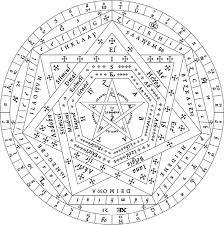
The Sigillum Dei (Sigillum Dei Aemeth), also known as the "Seal of Truth," is a mystical and esoteric symbol believed to have magical, spiritual, and alchemical significance. It originated in the works of medieval and Renaissance mystics, most notably John Dee, an English mathematician, astrologer, and occultist.
Overview of the Sigillum Dei Aemeth
Design:
The Sigillum Dei Aemeth is a complex diagram featuring a pentagram, heptagon (seven-pointed star), and surrounding circles filled with various letters, names, and symbols.
At the core is a pentagram, surrounded by names of God, angels, and celestial hierarchies, based on mystical calculations and religious texts.
Purpose:
It was purportedly used as a tool of protection, divine communication, and to access knowledge from the heavens or higher realms.
In Dee's practice, the Sigillum Dei served as a key for unlocking the Enochian system, which involves communication with angelic beings.
Associated Names:
The letters and names inscribed on the Sigillum Dei include divine and angelic entities as derived from cabalistic, Christian, and Hermetic traditions.
Etymology:
"Ameth" translates to "truth" in Hebrew, reinforcing the idea that the Sigil reveals divine truths.
Historical Use:
John Dee used it in his occult practices and described its construction and purpose in collaboration with Edward Kelley, his scryer.
The symbol was believed to have enormous power, often viewed as a key to unlocking the mysteries of the universe.
Symbolism and Interpretation
The Sigillum Dei integrates Christian theology, angelology, and Neoplatonic mysticism:
The Pentagram: Represents humanity, divine order, and protection.
Sevenfold Structures:
The seven points and divisions correspond to the seven days of creation, planets, archangels, or other sacred systems.
Seven was considered the number of divine harmony in many mystical traditions.
Outer and Inner Circles: Symbolize layers of divine emanation, enclosing and protecting the divine knowledge.
Mathematical and Alchemical Connections
The Sigillum Dei involves geometric and numerological symbolism:
Geometry:
Shapes such as the pentagram and heptagon reflect underlying principles of proportion, harmony, and symmetry.
These forms symbolize perfection in creation.
Alchemy:
The Seal correlates to alchemical transformations—transcending the base elements to approach the divine truth or philosopher’s stone.
Modern Influence
Today, the Sigillum Dei Aemeth is studied and appreciated in occult, esoteric, and historical contexts:
It’s revered in Hermetic and ceremonial magical traditions, particularly those that honor Dee’s Enochian systems.
The symbol remains influential in discussions of sacred geometry and mystical philosophies.
Would you like help deciphering specific parts of the sigil or exploring practical applications within mysticism, mathematics, or related topics?

The Tesla logo’s connection to a mathematical algorithm lies in its underlying symbolism and possible connections to geometrical or physical principles. The logo design represents a cross-section of an electric motor, reflecting elements of electromagnetism, geometry, and engineering rather than direct mathematical algorithms.
1. Geometrical Correlations in the Logo
The Tesla logo, resembling a stylized "T," has a symmetrical and streamlined shape that may evoke mathematical or geometric associations:
Symmetry and Curves: The arc on the top of the "T" relates to circular or elliptical geometry, similar to segments of a stator in an electric motor.
Engineering Design: The vertical line of the "T" is part of the rotor structure in Nikola Tesla’s AC motor. Geometry involving circles, rotations, and perpendicular interactions could be tied to the functional design.
2. Electromagnetic Foundations
Tesla Motors is inspired by Nikola Tesla, the pioneer of alternating current (AC) motors. The logo could metaphorically reference the electromagnetic principles and associated equations, such as:
Maxwell's Equations: These describe electromagnetism and can be summarized as a system of differential equations. They govern how electric and magnetic fields interact—essential to AC motor design.
\nabla \cdot \mathbf{E} = \frac{\rho}{\epsilon_0}, \quad \nabla \cdot \mathbf{B} = 0, \quad \nabla \times \mathbf{E} = -\frac{\partial \mathbf{B}}{\partial t}, \quad \nabla \times \mathbf{B} = \mu_0 \mathbf{J} + \mu_0 \epsilon_0 \frac{\partial \mathbf{E}}{\partial t}
AC Motor Algorithm: Nikola Tesla's motor design relies on rotating magnetic fields:
B(t) = B_0 \cos(\omega t)

3. Relationship to the Fibonacci Sequence or Golden Ratio
Some see a connection between the curves in the Tesla logo and Fibonacci spirals or the golden ratio (). This interpretation highlights the aesthetic appeal derived from nature's mathematical patterns:
The golden ratio is expressed as:
\phi = \frac{1 + \sqrt{5}}{2} \approx 1.618
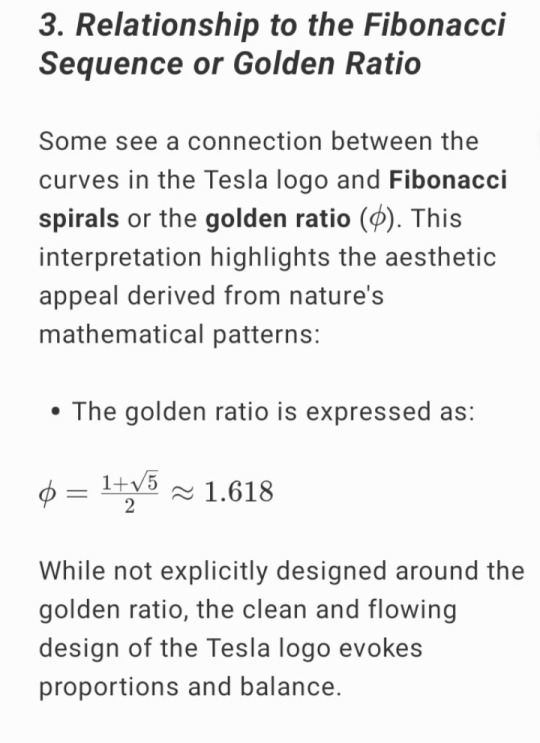
While not explicitly designed around the golden ratio, the clean and flowing design of the Tesla logo evokes proportions and balance.
4. Algorithmic Insights Related to Trajectories
The design might also connect metaphorically to:
Optimization Algorithms: Related to pathfinding and energy efficiency in the production and performance of electric vehicles.
Trajectory Mapping: Algorithms like Dijkstra’s or Kalman filters optimize energy consumption, similarly reflected in orbital flight and satellite positioning (a concern for Tesla’s SpaceX sibling company).
5. Freemason Symbol or Alchemical Interpretations
The Tesla logo, with its pointed arc and straight stem, can also invoke the visual symmetry of Freemason tools (the compass and square). While not directly related, such interpretations parallel studies in symbolic geometry.
Conclusion
While the Tesla logo itself does not have a direct mathematical algorithm, it embodies principles of:
Geometry: Circular arcs and symmetry.
Electromagnetism: Theories central to Tesla Motors' mission.
Aesthetics and Design: Patterns inspired by Fibonacci spirals or the golden ratio.
If you'd like, I can explore more detailed equations behind AC motor technology or optimization algorithms potentially related to Tesla's innovations. Let me know!
To explore correlations among all the mentioned symbols and mathematical principles—Tesla's logo, the Sigillum Dei, electrical motors, geometry, alchemy, and space trajectories—I'll break down each concept and attempt to correlate them using symbols, mathematics, and mysticism. This will incorporate themes from symbolic design, geometry, electromagnetism, alchemical symbolism, and more.
1. Tesla Logo and Geometrical Concepts
The Tesla logo represents a simplified view of an electric motor and can be connected to several geometrical and electrical principles:
Geometric Symmetry: The arc and straight stem are structurally symmetrical, akin to rotational symmetry seen in electric motors. For example, the rotation of a magnetic field in an alternating current (AC) motor is central to how Tesla's inventions work. This symmetry connects with circle, elliptical, and spiral geometries.
Electromagnetism in Action: The motion within an AC motor is derived from Maxwell's Equations, whose applications also give insight into designing electromagnetic systems such as Tesla coils, electric cars, and propulsion for space travel.
Relevant Equation:
\vec{E} = -\frac{\partial \vec{B}}{\partial t} \quad \text{(Faraday's Law of Induction)}
2. Sigillum Dei Aemeth and Geometrical Interpretations
The Sigillum Dei (Sigil of God, Seal of Truth) includes complex geometrical patterns. It symbolizes divine order and protection—connecting to mystical and alchemical principles. It carries elements such as:
Pentagrams and Sacred Geometry: These shapes form an ancient geometrical pattern representing harmony and balance within the cosmos.
Mathematical Precision and Mysticism: The Sigil contains letters, numbers, and shapes, corresponding to numerology, specific angelic communications, and esoteric truths—often coded to symbolic relations between numbers.
The Seal visually links sacred geometry to mystical philosophies, possibly influencing interpretations of space and time (i.e., interstellar travel). The pentagram as a fundamental geometric symbol in alchemy might also find correspondence with orbital and rotational dynamics in physics, suggesting that the universe’s “sacred designs” echo natural laws.
Connecting Equation: Euler's Identity (for inherent beauty and symmetry)
e^{i\pi} + 1 = 0

3. Alchemical Symbols and the Tesla Logo
Alchemy’s Seven Pillars: Many interpretations of the Sigillum Dei align with the seven traditional metals of alchemy (each element connected to a specific cosmic force). The number 7 often appears in mystical systems and in practical physics like angular momentum in orbital systems and rotations within motors.
Tesla as the "Alchemist of the Modern Age": Tesla's legacy is sometimes described as “mystical” due to his revolutionary work on energy transmission and wireless communication, which might metaphorically align with alchemy—transforming invisible forces (magnetic fields, electricity) into useful applications, paralleling the transformation of base metals into gold in alchemical practices.
4. Space Travel and Orbital Trajectory Algorithms
Space trajectories and propulsion are governed by principles such as Kepler’s Laws, orbital mechanics, and gravitational assists:
Orbital Calculations for Interstellar Travel: Interstellar travel would likely involve understanding space-time geometry and gravitational mechanics to break the bonds of Earth's orbit. The orbital trajectory for breaking free of Earth's gravity often uses calculations derived from Newtonian or Einsteinian physics.
Key Formulae:
Kepler's Third Law (Planetary Motion):
T^2 \propto r^3

Rocket Propulsion and Efficiency (Tsiolkovsky's Rocket Equation):
\Delta v = v_e \ln \left(\frac{m_0}{m_f}\right)

5. The All-Seeing Eye and Mysticism
The All-Seeing Eye—whether present in Freemasonry or as a symbol of divine oversight—represents the gaze of higher truth in understanding the cosmos, symbolizing a kind of divine mathematical order:
Perception and Divine Geometry: The eye (especially within geometrical symbols like the pyramid) may embody perspective—representing a higher, all-encompassing view of universal laws, from sacred geometry to the vastness of space.
Logos and Divine Mathematics: The “sight” connects divine foresight with the laws that govern the universe. If we align Divine Truth with mathematical models (e.g., curvature of spacetime, geometric harmony), a new level of understanding may emerge.
Final Correlations
Conceptual Integration:
Geometrical Precision in Nature: Many of the mystical symbols (Sigillum Dei, Tesla Logo, Sacred Geometry) embed perfect proportions and ratios that echo in natural phenomena—from planetary orbits to electromagnetic forces. Mathematics is thus the universal language connecting all these symbols through their inherent mathematical harmony.
Tesla's Technological Vision and Mysticism: Elon Musk and Tesla’s innovations in space travel and electric technology metaphorically resonate with sacred geometry, where precise mathematical principles guide not just practical engineering but also symbolic constructs like the Sigil of Truth and alchemical teachings.
In this light, mathematical algorithms for propulsion, orbital paths, sacred design, and energy transformations converge in a mystical, physical matrix that blurs the lines between engineering, mysticism, and alchemy.
Would you like to dive into any of these topics more deeply? Or perhaps explore specific algorithms more in-depth?
#tesla logo#algorithm#clowcards#sakura clow cards#clamp#the sigil of truth#de sigilum ameth#deardearestbrands#playstation7#bambiprescott#clairejorifvalentine#breaking through#star systems
5 notes
·
View notes
Text
What You Need to Know About Arc Segmentitle Magnets, Radial Axial Circle Magnets, Isotropic and Anisotropic Magnets
Magnets serve an important part in a variety of sectors today, including electric motors, generators, sensors, and magnetic assembly. Among the several varieties available, the Arc Segmentitle Magnet, Radial Axial Circle Magnet, and the distinction between Isotropic and Anisotropic Magnets stand out for their performance, shape, and magnetic qualities. But what do these phrases signify, and where do these magnets usually appear?

What is an Arc Segment Magnet?
An Arc Segment Magnet—an arc or segment magnet—is commonly employed in circular magnetic assemblies, notably brushless DC motors and permanent magnet motors. These magnets are shaped like a circle slice and are intended to be used around a rotor or stator.
Important characteristics:
Accurate curvature for a snug radial fit
Available in a variety of materials, such as ferrite, samarium cobalt, or neodymium (NdFeB).
Perfect for spinning systems with high speeds
High concentration of magnetic flux along the arc
Common Applications:
Drones and e-bikes with electric motors
Windmills
Couplings of magnets
Industrial robotics and servo motors
What Is a Radial Axial Circle Magnet?
A magnet with a circular or ring form with a magnetic direction that is either axial or radial is called a radial-axial circle magnet. The distribution of the magnetic field is determined by these orientations. In precision equipment, a radial-axial circle magnet is frequently specially made to meet certain torque or sensing requirements. Their specialized magnetic orientation and round shape guarantee little energy loss and excellent performance.
What Makes an Isotropic Magnet Different from an Anisotropic One?
Although materials like ferrite, neodymium, or rare earth compounds may be used to create both isotropic and anisotropic magnets, there are major differences in their production procedures and performance.
Conclusion
Knowing the differences between arc segmental magnets, radial axial circle magnets, and anisotropic / Isotropic Anisotropic Magnet magnets is essential for improving both your design and performance, whether you're an engineer creating the next high-efficiency motor or a manufacturer locating dependable magnetic components. Every magnet design and kind offers a unique set of benefits. Selecting the best one requires finding the ideal balance between cost-effectiveness, application fit, and magnetic strength.

Follow our Facebook and Twitter for more information about our product.
2 notes
·
View notes
Text
Samsung DC31-00111A Washer/Dryer Washer Drive Motor Stator | HnKParts

The Samsung DC31-00111A is a replacement washer drive motor stator for Samsung washing machines. This part is a BLDC motor, which is distinguished from conventional washing machine motors by its higher efficiency and perhaps longer lifespan. The stationary stator of the motor produces the force that rotates the washing machine drum in tandem with the rotor.Changing the stator can be done through specialised equipment and expertise.
If you're looking for a reliable replacement, the Samsung Washer/Dryer Washer Drive Motor Stator is an excellent choice for the smooth operation of your home appliance.
#Samsung#SamsungParts#DC31-00111A#HnKParts#homeappliances#HnKBuzz#KitchenApplianceParts#appliacepartsonline
2 notes
·
View notes
Text
Current Satisfactory Build!
Long post under construction
It's time for another build post! this one is still pretty early but I wanted to show it off anyway
Oil processing, plastic, rubber, and fuel production, as well as 7 generators producing 1750MW. Belt hallway still in progress, debating turning it into a railway after train unlock but still undecided. Will eventually be ths site of Bauxite processing because of the access to water. Bauxite miner is on the mountain just behind

Caterium and steel happened to be right next to eachother so I combined them in one facility. Quickwire at the bottom supplying high speed connectors above and eventually more processes
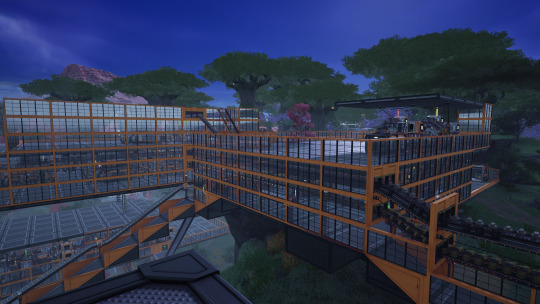
Steel production is right behind the quickwire. Steel currently maxed out at mk4 belts producing 480 steel ingots/min, 120 beams, and 40 pipes. I have 30/min iron being processed into plates and rods for local use, and I have an uploader on each

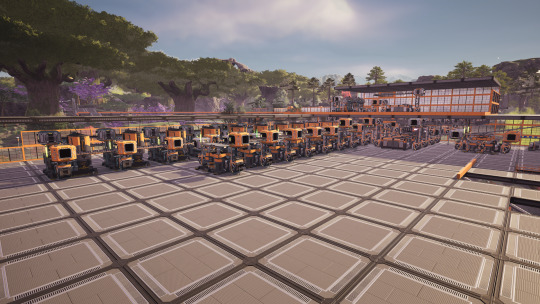
in front of, and underneath steel, coal power chuggs away producing 1350 MW supplementing the fuel generators. Coal and sulfur mix to produce compacted coal for better fuel efficency

And now my favorite part! My main facility where ALL the magic happens.

Floor 1 contains my main iron processing, churning out 600 ingots with plans to double.

The west end houses the copper plant making wire and cable throughout the rest of the facility, and also an uploader for each

Right next to copper is my backup biomass manifold. I have plans of installing priority power switches everywhere and using this as emergency power

Level 2 includes modular frames, rotors, smart plating, and reinforced plates, as well as
Copper sheets
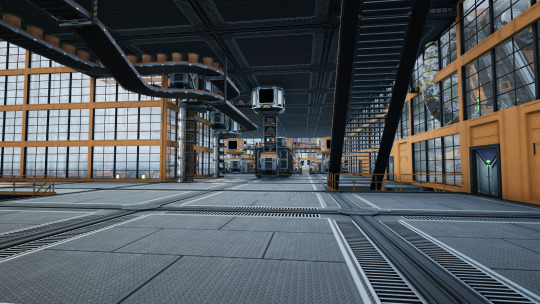

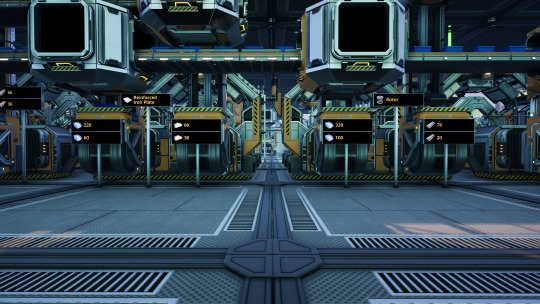
Level 3 has circuit boards, versatile framework, automated wiring, stators, and motors

Level 4 houses almost exclusively manufacturers for: computers, heavy modular frames, adaptive control units, and modular engines. I may expand level 4 as necessary.
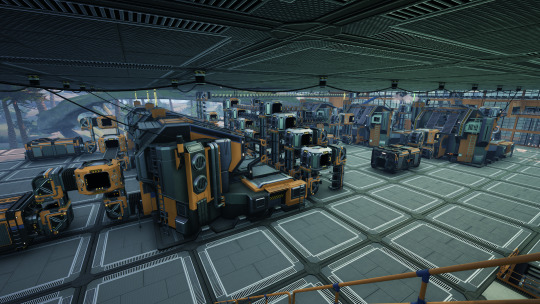
Belt spaghetti

Level 5 will make project parts for phase 4 though I may expand to level 6 as well. Not sure
Behind this megafactory is the space elevator. Its central location between the North and West wings make it easier move parts over


Not completely sold on this distribution system but I don't really have a better way at this particular point. Still serves the purpose but it is certainly spaghetti

Hopefully aluminum soon, trains soon, jetpack next
3 notes
·
View notes
Text
Research: Spaceship models (part 2)
Spot robot
this is a video showcasing the Spot robot, with is essentially a robotic dog.
With an insane introduction of dropping this thing from 20 feet above, it is able to get back up without its head due to smart motor arrangements mechanisms. The legs are bent backwards to allow easier overcoming of obstacles. Each leg has 2 motors, with the planetary gases connected to the motor and stator. The knees are connected with the stator and rotor, allowing both the upper and bottom parts to support each other. The leg measurements should closely resemble that of an actual dog so the robot doesn't immobilise itself.
Battery can be an issue for this complex machine. To avoid battery drainage, the knee motor should be closer to the hip joint since they're closer in weight.
For dexterity, the legs are made of carbon fibre with extended hinges, and the upper parts contain a ball screw to rotate the motors. Carrier arrests are placed for less linear movement, allowing the bottom parts to move in sync.
The robot is able to get up easily due to a motor-tilt motor sign connected to the hip motor, with sensors to decode a fall. the robot can also crawl and have mounting rails for holding objects like cameras. To climb down from stairs, the robot faces backwards.
All motors should correspond with force and compression.
youtube
Scratch built ship
This is a video about ships built from the ground up, presented by model maker in Wonderfest. Staring BP Taylor, who made 2 models. One's a kit bash, the repurposed 3-We, and the other is a scratch build of a spherical ship.
For the sphere ship, the front was vacuum formed and then sanded out to get a clear appearance. For the ship's designs, Taylor selects his items for the ship's look and sketches them out and establishes shapes first and forms later, with focus on the amount of detailing the ship should have. He also has to establish scale but putting parts together. A other of the items Taylor uses are either from remains of broken electronics, items from model kits or toys or general scrap parts. He airbrushes his complete builds in grundy and dull colours.
youtube
Jean "Moebius" Giraud and Jean-Claude Mézières
Jean Giraud, also known as Moebius, was a French artist who is most well known for his sci-fi and comic work. He is renowned for his and abstract concepts and fantastical art direction, working on many projects from comics to concept art for films like the Fifth Element and Tron.
Jean-Claude Mézière was also a French artist who primarily worked in comics. Inspired by the works of Jack Davis and Andre Franklin, his work also leans into sci-fi surrealism and is well renowned for it's uniqueness, with his style going on to inspire works like Star Wars. He also worked on The Fifth Element.
Wallace and Gromit: A Grand Day Out
Wallace and Gromit: A Grand Day Out is a 1989 stop motion short by Aardman Animation and the first Wallace and Gromit cartoon ever made, with the plot focusing on Wallace and Gromit's plan to visit the moon to get cheese.
In terms if technicality, Wallace and Gromit's stop motion animation has always been a marvel, and even here that's no exception. While more rigid and imperfect, it still has a ton of charm and is impressive. As for the spaceship itself, it is a simple cartoonish rocket in a plain orange.
youtube
youtube
As for the robot, it's also charming and non-complex. Not much to dy on it besides that like the cartoony arms.
youtube
Apollo spacecraft recreation
Heres's a video explaining the structure of the Apollo ship.
The launch vehicle used to send the poll to space, the Saturn V, has three parts: S-1C, which was powered by F1 rocket engines, S-II, which was powered by J2 rocket engines, and the S-IVG and was powered by one J2 rocket jet. Saturn V also contains other components to ensure that the ship can travel and land safely. The tower that holds up the Saturn V is called the launch umbilical tower which has 9 retractable arms to have inner access to the rocket.
The Saturn V speeds up upon flight, and the engines start to shut off and separate the higher the rocket is.
The Apollo has 3 parts: The command module, service module and lunar model.
youtube
Maya
Here's a tutorial on how to sculpt a space jet in Maya.
Staring with a cube, select smooth mesh and set division level stop 3 for the body of the jet. After setting up the symmetry tool, a few faces are selected in a square formation to form the inside of the cockpit and be able to use the circularise tool. To maintain symmetry, click on the evenly distribute option to order the faces into place.
Now to extrude. the selected area is scaled and pulled inside.To form the cockpit, a cube is summoned and mesh smoothed and transformed, with some copy and pasting to keep all shaped on the same base. then select the back of the shape and use soft select to extend and flatten it.
After messing the shape, the wings can be formed. In a new layer summon a box and scale it to a flat rectangle. Then you can do whatever you want with it, whether out be extruding, adding edges or bending with soft select. After that, the ship can reappear and have the wings scaled to its size.
To sooth out the ship, go to the mesh option and select smooth. Then you can add a rocket. Select a cylinder and scale it so the ends are pointy and turn up subdivision to turn it into a pill, with extrude used to put into the inside. Then the object is duplicated an placed on top of the ship.
youtube
2 notes
·
View notes
Text
Type And Advantage of Magnets In Electric Motors
Type And Advantage of Magnets In Electric Motors We all know that magnets are commonly used on motors, but the magnets used by different motors are not only different sizes, but also different shapes. The basic shapes are arc/wedge/bread-shaped, rectangle, ring and flat (plane) shapes, Let’s talk about their respective characteristics. First, Motor arc magnets (segment magnet, bread magnet,…
#AC motors#bonding neodymium iron boron#DC motors#Embedded Permanent Magnets#Ferrite magnet#high-performance permanent magnet motors#interior permanent magnet motors#IPM motors#Magnetic alloy#magnetic field#magnetic fields#magnetic flux density#magnetic forces#magnetic parameters#magnetic properties#Magnetic stators#Magnetic torque#magnetization direction#motor magnets#permanent magnet motors#Permanent Magnets#PM Motors#rotor and stator#SPM motors#surface permanent magnet motors#Surface Permanent Magnets
1 note
·
View note
Video
youtube
Exported to Russia gantry 125 tons of high-speed punching machine is sta...
0 notes
Note
*puts a water gun to your head and smiles sweetly* Crow/Amanda
It's my unwavering belief that proper Crow/Amanda MUST involve ship repair and maintenance. Do YOU want ME to write/draw something outside my usual body of work? Asks are open!
“It’s all ours,” Amanda Holliday beams, gloved hands on her hips, as she regards the abandoned jumpship. A true specimen of retro engineering locked in time by the desiccated atmosphere of 10 Pallas, they've been called out by its owner, who asks for nothing in payment except its removal.
“If we can get it to move,” Crow reminds. “Do you really think we can?”
“No ship’s bested us yet.” A determined smile spreads across her face as she opens the hood. "I don't intend for her to be the first!"
Crow approaches, already assessing the motor. Everything he knows about ship repair he learned from Amanda — an impromptu boot camp she insisted on after he almost blew up the Accipiter bringing it to jump-speed without sufficient coolant. So too had he gotten all his gear from her: the toolbelt and safety goggles and mechanic's jumpsuit all rummaged from her workshop. The heavy canvas garment is a smidge short on him and bears Holliday in red embroidery across the breast pocket. Somehow, the signs it's hers makes him cherish it even more.
"Looks pretty good, considering how long it's been here," he says, leaning into the engine bay. Amanda is already chest-deep into the compartment, fiddling around with … he can't see past the parts in front of him. "Maybe a little corrosion on the rotors."
"Stators," Amanda corrects.
"Stators, right."
"Gimme the wrench, would'ya? Blue handle," she specifies, and Crow rummages through the toolbox to find it. Hands it to her, their gloved fingertips brushing as he passes it off.
While she works on that, he tasks himself with cleaning rust, checking wiring against schematics sent to Glint, and sweeping out a long-abandoned bird's nest in the turbine. Hours of pleasantly monotonous work pass. Amanda eventually emerges, smudged in more grease than usual, and climbs into the cockpit to run system tests. Finds the power shot.
Crow rotates sternward, locating the fuel cell. Disengages the lock, and pulls the handle — nothing. He gives the block a second yank, two-handed this time, and still cannot move it.
"We might have a little problem," Crow hedges, and Amanda wanders out back. "The cell's stuck. Like, stuck-stuck."
"Ah, for the love of—" Amanda mumbles, bracing herself against the ship with one leg, and giving it a pull. She doesn't unseat it, but manages to budge it slightly.
"Maybe if we both pull. . ." Crow approaches behind Amanda, "May I?"
Amanda nods. There's no way not to press against as he wraps his chest around shoulders, gripping the pull on either side of her hands. She counts down, three-two-one, and they heave together. The flex of her muscular triceps against his sinuous arms flusters him enough that he has to remind himself to hold on —
There's a heavy mechanical clack as it slides from the receptacle, both giving a long exhale of relief.
When they finally replace it and finish diagnostics, the ship starts easily. Amanda excitedly springs from the cabin, practically jumping into Crow's arms with jubilation. "We did it!" She exclaims, as he swings her around in a hug.
"I'm so happy I could –" she looks into his eyes, and flicks her gaze away with a rosy blush. "Well, I could kiss y–"
He presses his lips to her forehead in a quick, sweet kiss. "I could too."
8 notes
·
View notes
Text
Torque in induction motor and relationship with power factor.
the torque in induction motor is proportional to the product of flux per stator pole and the rotor current one more term we will take in account is power factor of the rotor.
T → φ * I₂ * cos∅₂
Where φ - flux per status pole
I₂ - rotor current
cos∅₂ - rotor power factor
The induced rotor EMF E2 is proportional to flux per status φ.
Therefore T = K1 * E₂ * I₂ * cos∅₂
Where K1 is another constant.
∅₂ phase angle rotor current and rotorEMF.
From the above equation it is clear that when φ2 increases cos∅₂ decreases and vice versa.
due to the revolving stator flux EMF is induced in rotor conductor, and this EMI is also sinusoidal.
When rotor is non inductive.

φ₂=0
in this case rotor current is in phase with rotor EMF. So the instantaneous value of torque is product of instantaneous value of flux and current. It is seen that torque is always positive.
When rotor is inductive load.

in inductive load I₂ lags behind E₂ bY an angle φ2.
φ2 = tan-¹(X₂/R₂ )
R2 = rotor resistance per phase
X2 = rota reactance per phase at standstill.
Its clear from diagram that portion of torque is reverse direction and hence the total torque is difference of forward torque and reverse torque. When φ2 = 90 degree then reverse torque equals to forward torque and total torque is equals to zero so the motor will not run.
2 notes
·
View notes